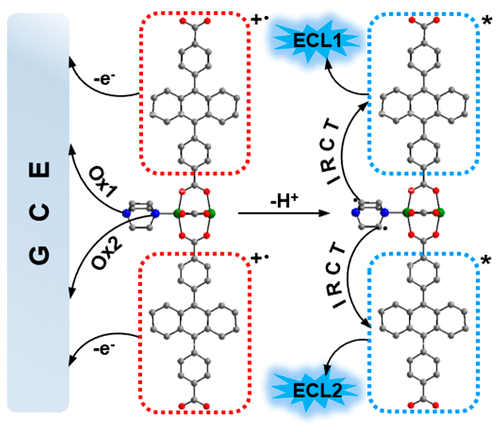当前位置:
X-MOL 学术
›
J. Am. Chem. Soc.
›
论文详情
Our official English website, www.x-mol.net, welcomes your
feedback! (Note: you will need to create a separate account there.)
Dual Intrareticular Oxidation of Mixed-Ligand Metal–Organic Frameworks for Stepwise Electrochemiluminescence
Journal of the American Chemical Society ( IF 14.4 ) Pub Date : 2021-02-17 , DOI: 10.1021/jacs.1c00001 Da Zhu 1 , Yong Zhang 2 , Songsong Bao 3 , Ningning Wang 1 , Siqi Yu 1 , Rengan Luo 1 , Jing Ma 2 , Huangxian Ju 1 , Jianping Lei 1
Journal of the American Chemical Society ( IF 14.4 ) Pub Date : 2021-02-17 , DOI: 10.1021/jacs.1c00001 Da Zhu 1 , Yong Zhang 2 , Songsong Bao 3 , Ningning Wang 1 , Siqi Yu 1 , Rengan Luo 1 , Jing Ma 2 , Huangxian Ju 1 , Jianping Lei 1
Affiliation

|
This work presents a mixed-ligand metal–organic framework (m-MOF) integrated with two ligands, one as a luminophore and the other as a coreactant, on one metal node for self-enhanced electrochemiluminescence (ECL). Both 9,10-di(p-carboxyphenyl)anthracene (DPA) and 1,4-diazabicyclo[2.2.2]octane (D-H2) ligands can be oxidized, generating the cation radicals DPA+• and D-H2+•, respectively. The latter can be deprotonated to form the neutral radical (D-H•) and then react with DPA+• to produce excited DPA* for ECL emission without exogenous coreactants. As a result of the incorporation into the MOF framework and the intrareticular charge transfer between the two ligands, the ECL intensity of the m-MOF was increased 26.5-fold compared with that of the mixture of DPA and D-H2 in aqueous solution. Moreover, with the process of second oxidation of D-H2, stepwise ECL emission was observed as a result of local excitation in the DPA unit, which was identified through density functional theory calculations. Overall, the implementation of the mixed-ligand approach, which combines the luminophore and coreactant as linkers in reticular materials, enriches the fundamentals and applications of ECL systems.
中文翻译:

配位体金属-有机骨架的双重网状氧化用于逐步电化学发光
这项工作提出了一种混合配体的金属有机骨架(m-MOF),在一个金属节点上集成了两个配体,一个作为发光体,另一个作为共反应剂,用于自增强电化学发光(ECL)。9,10-二(对羧基苯基)蒽(DPA)和1,4-二氮杂双环[2.2.2]辛烷(DH 2)配体均可被氧化,分别生成阳离子自由基DPA +•和DH 2 +•。 。后者可被去质子化以形成中性基团(DH •),然后与DPA +•反应。在没有外源共反应物的情况下产生用于ECL发射的激发DPA *。由于掺入MOF骨架和两个配体之间的网状电荷转移,与水溶液中DPA和DH 2的混合物相比,m-MOF的ECL强度提高了26.5倍。此外,在DH 2的第二次氧化过程中,由于DPA单元中的局部激发而观察到逐步的ECL发射,这通过密度泛函理论计算确定。总体而言,混合配体方法的实现将网状材料中的发光体和共反应剂结合为连接剂,这丰富了ECL系统的基础和应用。
更新日期:2021-03-03
中文翻译:

配位体金属-有机骨架的双重网状氧化用于逐步电化学发光
这项工作提出了一种混合配体的金属有机骨架(m-MOF),在一个金属节点上集成了两个配体,一个作为发光体,另一个作为共反应剂,用于自增强电化学发光(ECL)。9,10-二(对羧基苯基)蒽(DPA)和1,4-二氮杂双环[2.2.2]辛烷(DH 2)配体均可被氧化,分别生成阳离子自由基DPA +•和DH 2 +•。 。后者可被去质子化以形成中性基团(DH •),然后与DPA +•反应。在没有外源共反应物的情况下产生用于ECL发射的激发DPA *。由于掺入MOF骨架和两个配体之间的网状电荷转移,与水溶液中DPA和DH 2的混合物相比,m-MOF的ECL强度提高了26.5倍。此外,在DH 2的第二次氧化过程中,由于DPA单元中的局部激发而观察到逐步的ECL发射,这通过密度泛函理论计算确定。总体而言,混合配体方法的实现将网状材料中的发光体和共反应剂结合为连接剂,这丰富了ECL系统的基础和应用。






























 京公网安备 11010802027423号
京公网安备 11010802027423号